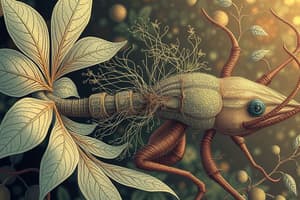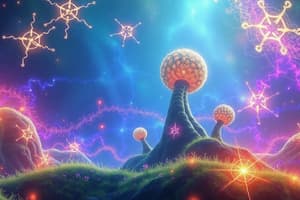Podcast
Questions and Answers
What does the term 'biology' originate from?
What does the term 'biology' originate from?
Which of the following groups is NOT included in the 3 Domain System?
Which of the following groups is NOT included in the 3 Domain System?
What type of cells do organisms in the domain Eukarya have?
What type of cells do organisms in the domain Eukarya have?
How are species named in the binomial naming system?
How are species named in the binomial naming system?
Signup and view all the answers
Which of the following is an example of a kingdom in biological classification?
Which of the following is an example of a kingdom in biological classification?
Signup and view all the answers
Approximately what percentage of land and sea species have not been discovered yet?
Approximately what percentage of land and sea species have not been discovered yet?
Signup and view all the answers
What categorizes organisms into different groups in biological classification?
What categorizes organisms into different groups in biological classification?
Signup and view all the answers
Which statement is true regarding prokaryotic cells?
Which statement is true regarding prokaryotic cells?
Signup and view all the answers
What is the smallest unit capable of sustaining life?
What is the smallest unit capable of sustaining life?
Signup and view all the answers
What is one property that defines all living organisms?
What is one property that defines all living organisms?
Signup and view all the answers
Which characteristic is considered part of metabolism?
Which characteristic is considered part of metabolism?
Signup and view all the answers
Why are bacteria considered the most numerous unicellular organisms?
Why are bacteria considered the most numerous unicellular organisms?
Signup and view all the answers
Which of the following properties of life allows organisms to maintain a stable internal environment?
Which of the following properties of life allows organisms to maintain a stable internal environment?
Signup and view all the answers
Which of the following statements about living organisms is true?
Which of the following statements about living organisms is true?
Signup and view all the answers
Which property of life includes the ability to change over time based on environmental pressures?
Which property of life includes the ability to change over time based on environmental pressures?
Signup and view all the answers
What distinguishes multicellular organisms from unicellular organisms?
What distinguishes multicellular organisms from unicellular organisms?
Signup and view all the answers
What is the primary purpose of metabolism in an organism's cells?
What is the primary purpose of metabolism in an organism's cells?
Signup and view all the answers
Which molecule is created when glucose is broken down in cells?
Which molecule is created when glucose is broken down in cells?
Signup and view all the answers
What does growth in multicellular organisms primarily result from?
What does growth in multicellular organisms primarily result from?
Signup and view all the answers
Which of the following best describes the nature of organisms' responses to the environment?
Which of the following best describes the nature of organisms' responses to the environment?
Signup and view all the answers
What type of reproduction involves genetic information from one parent?
What type of reproduction involves genetic information from one parent?
Signup and view all the answers
What term describes the ability of living species to change over generations?
What term describes the ability of living species to change over generations?
Signup and view all the answers
Which statement accurately describes homeostasis?
Which statement accurately describes homeostasis?
Signup and view all the answers
Which of the following examples illustrates a response to temperature changes in organisms?
Which of the following examples illustrates a response to temperature changes in organisms?
Signup and view all the answers
What is the primary function of thermoregulation in humans?
What is the primary function of thermoregulation in humans?
Signup and view all the answers
Which of the following is NOT one of the eight functions that humans must perform to maintain life?
Which of the following is NOT one of the eight functions that humans must perform to maintain life?
Signup and view all the answers
Why is ATP essential for human survival?
Why is ATP essential for human survival?
Signup and view all the answers
What role do the nervous and endocrine systems play in homeostasis?
What role do the nervous and endocrine systems play in homeostasis?
Signup and view all the answers
Which survival need is primarily responsible for providing the environment for chemical reactions?
Which survival need is primarily responsible for providing the environment for chemical reactions?
Signup and view all the answers
What does homeostasis refer to in human biology?
What does homeostasis refer to in human biology?
Signup and view all the answers
Which of the following processes is involved in maintaining boundaries in the human body?
Which of the following processes is involved in maintaining boundaries in the human body?
Signup and view all the answers
What temperature range is considered normal for a healthy adult's core body temperature?
What temperature range is considered normal for a healthy adult's core body temperature?
Signup and view all the answers
What initiates the positive feedback mechanism during childbirth?
What initiates the positive feedback mechanism during childbirth?
Signup and view all the answers
What role do stretch receptors play during childbirth?
What role do stretch receptors play during childbirth?
Signup and view all the answers
What eventually stops the process of platelet activation?
What eventually stops the process of platelet activation?
Signup and view all the answers
Which hormone is primarily released during the childbirth process?
Which hormone is primarily released during the childbirth process?
Signup and view all the answers
Why is it important to review lecture notes within 24-48 hours after class?
Why is it important to review lecture notes within 24-48 hours after class?
Signup and view all the answers
What is NOT a recommended tip for succeeding in biology?
What is NOT a recommended tip for succeeding in biology?
Signup and view all the answers
What does a positive feedback mechanism involve?
What does a positive feedback mechanism involve?
Signup and view all the answers
How should students engage with their learning to succeed?
How should students engage with their learning to succeed?
Signup and view all the answers
Study Notes
Properties of Life
- Biology derives from the Greek "bio" (life) and "ology" (study of).
- Organisms are classified based on shared characteristics into various taxonomic groups, such as mammals, reptiles, amphibians, fish, invertebrates, and birds.
- A significant percentage of species remain undiscovered: 86% of terrestrial species and 91% of marine species.
Biological Classification
- Millons of species exist on Earth, classified into three main domains:
- Bacteria: Prokaryotic organisms without a nucleus.
- Archaea: Also prokaryotic, often extremophiles.
- Eukarya: Organisms with eukaryotic cells that have a nucleus.
- The biomial naming system assigns each organism a unique genus and species name (e.g., Escherichia coli, Homo sapiens).
Key Characteristics Defining Life
- Composed of cells: Unicellular (single-celled) or multicellular (many cells), with the cell being the basic unit of life.
- Metabolism: Organisms require energy for chemical reactions, converting food to energy via ATP.
- Growth and development: Organisms increase in size and develop specialized structures from simpler forms.
- Response to environment: Organisms react to stimuli like odor, temperature, and light.
- Reproduction: All organisms reproduce sexually or asexually to propagate their species.
- Evolution and adaptation: Species change over generations, adapting to environments through natural selection.
- Homeostasis: The ability to maintain stable internal conditions despite external changes, crucial for health.
Specific Functions of Humans
- Eight vital processes humans must perform to maintain life:
- Growth and development.
- Reproduction (sexual and asexual).
- Responsiveness to environmental changes.
- Movement for interaction with surroundings.
- Metabolism involving energy processing.
- Maintenance of boundaries (cellular and bodily).
- Digestion for breaking down food.
- Excretion for waste removal.
Survival Needs
- Oxygen: Essential for ATP production.
- Water: Provides a medium for metabolic reactions.
- Nutrients: Supply energy and building blocks for cells.
- Normal body temperature: Necessary for chemical reactions at life-sustaining rates.
Homeostasis Mechanisms
- Homeostasis ensures environmental stability for organ systems, with the nervous and endocrine systems playing key roles.
- Examples of homeostatic processes include thermoregulation where the body maintains a core temperature between 36-37.5°C.
- Positive feedback mechanisms illustrated by childbirth: pressure on the cervix triggers hormone release for continued contractions until delivery occurs.
Tips for Succeeding in Biology 985
- Regularly review the course outline for critical dates and topics.
- Pre-read lecture material to enhance understanding.
- Actively attend and take condensed notes during lectures; supplementary powerpoints will be provided online.
- Rewrite notes post-class for clarity and comprehension, creating vocabulary lists to track new terms.
- Review lecture objectives diligently to solidify understanding.
- Seek help proactively from instructors for any difficulties before exam time.
Learning Approach
- Engage actively in the learning process: discussions, writing, relating content to real-life experiences enhances retention and understanding.
Studying That Suits You
Use AI to generate personalized quizzes and flashcards to suit your learning preferences.
Description
Explore the fundamental properties that define life in this quiz. Learn about biological classification, the major taxonomic groups, and the characteristics that distinguish living organisms. Test your knowledge on important concepts such as cellular composition and metabolic processes.




